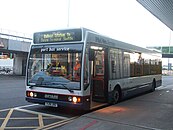Optare Excel
This article needs additional citations for verification. (March 2016) |
| Optare Excel/NABI 700SE | |
|---|---|
 | |
| Overview | |
| Manufacturer | Optare |
| Production | 1995-2004 |
| Body and chassis | |
| Doors | 1 or 2 |
| Floor type | Low floor Step-entrance (NABI 700SE) |
| Powertrain | |
| Engine | Cummins B Series/ISBe Mercedes-Benz OM906LA |
| Capacity | 27-45 seated |
| Transmission | Allison B300R |
| Dimensions | |
| Length | 9.6 m (31 ft 6 in) 10 m (32 ft 10 in) 10.7 m (35 ft 1 in) 11.5 m (37 ft 9 in) |
| Width | 2.5 m (8 ft 2 in) |
| Chronology | |
| Predecessor | Optare Delta Optare Sigma |
| Successor | Optare Tempo |
The Optare Excel was a low-floor full-size single-decker bus manufactured by Optare. Manufactured as an integral bus, the Excel was launched in 1995 as one of the first low floor single-deck vehicles, replacing the step-entrance Optare Sigma. The styling of the body was in keeping with existing Optare products. At the front, a simple flat panel with the Optare name was set between two pairs of twin headlamps, below a very large front windscreen. Approximately 600 were built.[1]
Powertrain
[edit]Power came from a Cummins 6BT, a 6-cylinder turbo diesel engine. A Mercedes-Benz OM906LA engine was an option with the Excel 2. Both transmitted their power via an Allison B300R gearbox.
Lengths
[edit]The Excel was built in a range of lengths, and in Optare tradition, the chassis code reflected this. An L960 was 9.6m in length; an L1000 was 10.0m in length, and so on; with L1070 and L1150 variants built. Seating ranged from 27 in the L960, 35 in the L1070, 43 in the L1150 and 45 in the L1180, although these figures can vary.
Excel 2
[edit]The Excel was updated in 1999, with the front similar to that of the Optare Solo and with round headlights, two less rear lights, and a repositioned fuel-filler cap. This was known as the Excel 2, which also replaced the Delta which by then had finished production, as well as the original Excel, which was still being sold until late 2000. Excel 2s were only built in L1070, L1150 and L1180 configurations.
Operators
[edit]The first production examples of the Excel were purchased by Blackpool Transport in 1996, followed by orders from Nottingham City Transport and Reading Buses.[2] Reading, a popular customer of Optare buses, would later go on to purchase 45 Excels from 1997 to 2000, as well as taking on second-hand acquisitions. These included 15 Excels purchased new by Cardiff Bus in 1997.[3][page needed]
Trent Buses were the biggest operator of Excels, ordering a total of 112 of the type from 1998 to 2001.[4][page needed]
East Yorkshire Motor Services purchased a total of 24 Excels between 1996 and 1999 for low-floor operations in Kingston upon Hull and Scarborough,[5][2] while 16 Excels were purchased by the Stagecoach Group in 2001 for operation in Worksop with their East Midlands subsidiary.[6] First Leicester purchased ten Excels in 1997,[7] while Go North East also purchased examples.[8]
In London, London United purchased six Excels in 1997, initially branded for use on route 371,[9][page needed] while Metrobus purchased ten a year prior.[2][10][page needed] Other London operators included Travel London and Thorpes, the latter purchasing four Excels for operation on the wheelchair-friendly Stationlink network.[2]
Optare also built a small export market for the Excel, selling examples to Malta and Hungary.[11] The Hungarian models were badged as the NABI 700SE and had three-door Excel bodies built on the Scania L94UB chassis.[12]
Replacement
[edit]The Excel was replaced by the Optare Tempo, but the design is used for another Hungarian market bus, this time the NABI 700SE, which uses a Scania powerplant.
Gallery
[edit]-
Lodges Coaches Optare Excel 1 in High Easter in August 2010
-
First Devon and Cornwall Optare Excel 1 in Plymouth in 2012
-
P&O Ferries Optare Excel 2 running a port bus service in Dover in September 2012
-
Safeguard Coaches Optare Excel 2 in Guildford in January 2009
References
[edit]- ^ Optare Excel Bus Lists on the Web
- ^ a b c d Jones, Stewart (3 May 1996). "Excel - Optare's low floor takes to the road". Bus & Coach Buyer. No. 356. Spalding: Glen-Holland Limited. pp. 9–13.
- ^ Street, Mike (15 May 2021). Buses and Coaches in Wales: 1980 to 2001. Stroud: Amberley Publishing. ISBN 978-1-3981-0160-9. Retrieved 27 December 2021.
- ^ Jenkinson, Keith A. (15 August 2020). The History of Optare. Stroud: Amberley Publishing. ISBN 978-1-4456-9695-9. Retrieved 27 December 2021.
- ^ Aldridge, John (February 1999). "Buses Profile: East Yorkshire Motor Services". Buses Focus. Shepperton: Ian Allan Publishing. pp. 20–22.
- ^ "Stagecoach orders Optare buses". Mass Transit. No. 27. University of Michigan: PTN Publishing Company. 2001. p. 56. Retrieved 26 December 2021.
- ^ Cole, Martin (15 August 1997). "Public reaction to the new FirstBus standard". Bus & Coach Buyer. No. 422. Spalding: Glen-Holland Limited. pp. 18–19.
- ^ "Fleet Additions". Bus & Coach Buyer. No. 422. Spalding: Glen-Holland Limited. 15 August 1997. p. 21.
- ^ Beddall, David (15 November 2020). London's Low-floor Buses. Stroud: Amberley Publishing. ISBN 978-1-3981-0120-3. Retrieved 27 December 2021.
- ^ Stubbings, Richard (15 July 2019). British Independent Buses in the 1990s. Stroud: Amberley Publishing. ISBN 978-1-4456-8612-7. Retrieved 27 December 2021.
- ^ Jones, Stewart (7 March 1997). "UK built low floor buses for overseas markets". Bus & Coach Buyer. No. 399. Spalding: Glen-Holland Limited. p. 17.
- ^ "Excel goes to Budapest". Coach & Bus Week. No. 530. Peterborough: Emap. 20 June 2002. Archived from the original on 18 September 2002. Retrieved 14 July 2024.
External links
[edit]![]() Media related to Optare Excel at Wikimedia Commons
Media related to Optare Excel at Wikimedia Commons




